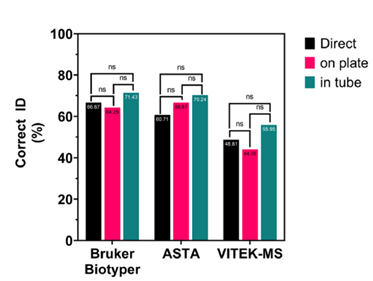우수연구성과
Chung-Ang University Researchers Evaluate Mass Spectrometry Approaches for Mold Identification
RESEARCH
NEWS STORY
Chung-Ang University Researchers Evaluate Mass
Spectrometry Approaches for Mold Identification
This study compares the efficacy of three mass spectrometry instruments and sample preparation
techniques for the clinical diagnosis of mold
Filamentous
fungi (molds) are a major cause of life-threatening infections in
immunocompromised individuals. Hence, there is an urgent need for their rapid
and accurate identification. While matrix-assisted laser desorption ionization-time
of flight mass spectrometry (MALDI-TOF MS) has demonstrated high sensitivity in
this respect, its clinical applicability is limited by lack of data and standardization.
Now, researchers have evaluated the clinical performance and accuracy of various
MALDI-TOF MS approaches for the diagnosis of mold infections.

Image Title: Identification sensitivity
of three MALDI-TOF mass spectrometry (MS) systems for the identification of
filamentous fungi
Image Caption: The sensitivity and
accuracy of three MALDI-TOF MS approaches for the identification of filamentous
fungi was determined by researchers from Chung-Ang University.
Image Credit: Prof. Mi-Kyung Lee from Chung-Ang University
License type: Original content
In recent years, filamentous fungi or
molds have emerged as causative agents underlying life-threatening infections
in immunocompromised individuals. The timely management of these infections requires
the rapid and accurate diagnosis of mold in clinical settings.
Unfortunately, traditional methods are
time consuming, given the long incubation periods required to culture and examine
molds. On the other hand, advanced molecular techniques are more sensitive and efficient.
One such technique that can detect filamentous fungal isolates with
high-sensitivity and reproducibility, is “matrix-assisted laser desorption
ionization-time of flight mass spectrometry (MALDI-TOF MS)”. It can
differentiate between samples based on variations in mass and charge. However, it
is not widely used due to limitations in database availability and a lack of
standardized procedures.
Recently, a team of researchers from Chung-Ang
University, Republic of Korea led by Professor Mi-Kyung Lee, evaluated three different MALDI-TOF MS approaches used in domestic clinical
settings, for the identification of molds.
In their study published in The Journal of Clinical Microbiology on October 26, 2022, they compared the
performance and diagnostic accuracy of the Bruker Biotyper,
ASTA MicroIDSys, and Vitek MS. They also assessed the sensitivity of three
pretreatment methods— “direct”, “on plate”, and “in tube”—using 84 filamentous
fungal isolates.
Explaining the rationale behind their study, Prof. Lee remarks, “Selecting an
appropriate sample preparation method can improve the efficiency and accuracy
of mold identification. Additionally, the development of systemized processes
at the diagnostic level can ultimately contribute to effective treatments for
patients”
The study found that the Bruker Biotyper identified 71.43% of isolates
correctly up to the species or genus level, while ASTA MicroIDSys and Vitek MS demonstrated
accuracy rates of 70.24% and 55.95%, respectively. Furthermore, the direct
method for sample preparation was favorable over the other two methods, owing
to its simplicity and ease of application. Notably, identification sensitivity did
not differ significantly across different sample preparation methods.
The rate of misidentification is an important consideration in clinical
laboratories because it can lead to inappropriate treatment interventions for
patients. In this study, only one isolate was misidentified using Vitek-MS
with the on-plate method. Moreover, the species level identification of Aspergillus
(a highly prevalent and clinically significant microorganism) was highest through
Vitek-MS, indicating the applicability of this technique in clinical settings.
The number of incorrectly identified species were 17, 15, and 23 through
the Bruker Biotyper, ASTA MicroIDSys, and Vitek MS, respectively. The team
suggested the need for additional evaluations if misidentification occurred due
to the absence of certain species in the library rather than an error. Furthermore,
the team determined that any differences in sensitivity could be attributed to
differences in the system databases.
In summary, MALDI-TOF MS is a valuable technique that can accurately
identify clinically significant microorganisms in a timely manner. Process
standardization and guidelines that can be applied to a wide range of species can
help reduce the process bias occurring through these techniques. Additionally,
limitations related to acquisition parameters, matrix quality, and hardware
require further assessments.
When asked about the applications of the study, Prof. Lee says, “Our
study is the first to compare the sensitivity and accuracy of three MALDI-TOF
MS instruments as well as the efficacy of three pretreatment methods for
filamentous fungal identification. Accurate results obtained through a
simple and streamlined process for mold identification using MALDI-TOF MS could
improve laboratory work efficiency for users and treatment efficiency for patients.”
Reference
|
Authors
Title of original
paper
Journal |
Yoojeong Choia, Daewon Kimb, Kye Won
Choea, Hyukmin Leec, Jae-Seok Kimd,
Jeong-Yeal Ahnb, and Mi-Kyung Leea
Performance Evaluation of Bruker Biotyper, ASTA MicroIDSys, and
VITEK-MS and Three Extraction Methods for Filamentous Fungal Identification
in Clinical Laboratories
Journal of Clinical Microbiology |
|
|
|
|
DOI
Affiliations |
aDepartment
of Laboratory Medicine, Chung-Ang University College
of Medicine, Seoul, Republic of Korea bDepartment
of Laboratory Medicine, Gachon University Gil Medical Center, Incheon,
Republic of Korea cDepartment
of Laboratory Medicine and Research Institute of Bacterial Resistance, Yonsei
University College of Medicine, Seoul, Republic of Korea dDepartment
of Laboratory Medicine, Kangdong Sacred Heart Hospital, Hallym University
College of Medicine, Seoul, Republic of Korea |
About Chung-Ang
University
Chung-Ang University is a private comprehensive research university
located in Seoul, South Korea. It was started as a kindergarten in 1916 and
attained university status in 1953. It is fully accredited by the Ministry of
Education of Korea. Chung-Ang University conducts research activities under the
slogan of “Justice and Truth.” Its new vision for completing 100 years is “The
Global Creative Leader.” Chung-Ang University offers undergraduate,
postgraduate, and doctoral programs, which encompass a law school, management
program, and medical school; it has 16 undergraduate and graduate schools each.
Chung-Ang University’s culture and arts programs are considered the best in
Korea.
Website: https://neweng.cau.ac.kr/index.do
